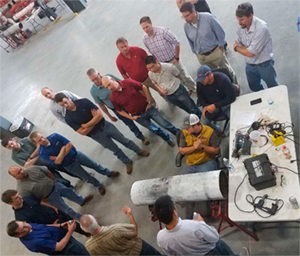API 1183 Dent Management Workshop
Led by Joe Bratton and Shanshan Wu
October 24, 2024 | PRCI’s Technology Development Center | Houston
This course will be held at
PRCI’s Technology Development Center
in Houston.

Course OVERVIEW
This course is for engineers responsible for the assessment of dent features identified during in-line inspections (ILI) of pipeline systems in accordance with the first edition of API Recommended Practice 1183 “Assessment and Management of Dents in Pipelines”. API RP 1183 is designed to help maintain the structural integrity of pipelines by addressing mechanical issues. It gives operators the tools needed to help ensure pipeline infrastructure is safe, reliable, and efficient. PHMSA regulations 49CFR192.712(c) provides requirements for performing a dent engineering critical assessment (ECA). API RP 1183 provides assessment methodologies to satisfy these regulations. It is expected that 45CFR195 will update regulations and require similar requirements for dent ECAs.
The course will teach students practical techniques for the assessment of dents and performing ECAs that satisfy regulatory requirements. The course includes and provides instructions on the use of API 1183, 1st edition. Case studies will also be presented to help guide the proper use of performing dent ECAs and their limitations. Advanced assessment methods will also be presented, utilizing finite element assessment (FEA). Guidance on indenter profile matching, model set up, modeling steps, and post processing will also be presented. In addition, considerations to mitigation and repair strategies will be covered during the course.
Learning Objectives
At the completion of this course, students will be able to
- Understand the formation of dents and failure mechanisms
- Learn how to perform dent strain calculation and determine strain acceptance limitations per ASME B31.8
- Learn how to calculate dent remaining lives using methodologies provided in API RP 1183
- Understand a process for performing dent ECAs in accordance with 49CFR192.712(c)
Prerequisites
Entering this course, you should have a basic understanding of pipeline integrity management programs, such as:
- Regulation requirements based on 49CFR 192 and/or 195
- Basic in-inspection technologies – caliper, MFL, and crack detection
- Understanding of typical ILI data, reports, and spreadsheets
Who should attend
This course is for practicing pipeline professionals responsible for the assessment of dent features identified during in-line inspections (ILI) or direct examination of pipeline systems. This includes pipeline engineers and operators, computational modelers, ILI analysts, excavation inspectors, NDE service providers and field support team.
Course Outline
Day 1 – 8 am
- Introduction and Background (2 hours)
- Background
- Lessons learned from industry incidents and trends related to mechanical damage
- Developments of dent assessment standards and best practices (e.g., ERPG, ASME B31.8, API RP 1156, and API RP 1183)
- Overview of a dent management process
- Introduction to dent management fundamentals
- ILI technology and capabilities
- Introduction to the dent formation process
- Regulatory Requirements
- US regulations overview
- Regulatory directions
BREAK
- Fundamentals of Dent Assessments (2 hours)
- Discussions on dent restraint conditions
- Interaction rules
- Review of dent signal data and caliper measurements
- Dent strain calculations
- Remaining fatigue life methodologies
Midday break – Noon to 12:45
- Overview of Advanced Dent Assessment (1.5 hours)
- FEA Modelling
- Material consideration and assumptions
- Types of elements (solid vs. shell)
- Modelling constraint conditions
- Indenter setup
- Interacting features
- Modelling steps
- FEA model post-processing
- FEA-based fatigue assessment
- Fracture mechanics model vs. S-N curve
- Appropriate safety factors to consider
- FEA-based strain and stress analysis
- Ductile failure damage indicator (DFDI)
- Strain limit damage (SLD)
BREAK
- Dent ECA Compliant to PHMSA Regulations (2 hours)
- Developments of the dent ECA process
- PHMSA regulation requirements
- Dent ECA process overview
- Background data review
- Review of historical ILI data
- Comparison of dent caliper measurements
- Ariel images review
- Examples
- Threat Interaction review
- Review for potential ground movement and other external loading
- Review for potential interaction with other features (e.g., ML, dent)
- Accounting for material property uncertainties and model inaccuracies and ILI tool sizing tolerances
- Remaining life analysis
- Consideration of operational data
- Fatigue life prediction models
- Safety factors
- Reassessment intervals
- Strain damage analysis
- Curvature-based strain analysis
- Strain limit discussion
- DFDI and SLD
- Case study
- Repair and Mitigation (0.5 hour)
- Field excavation and backfill best practices
- Selection of field NDE technologies
- Mitigation methods
- Repair methods
CEU
On completion of the course, participants will be eligible to receive .7 Continuing Education Units (CEU’s).

